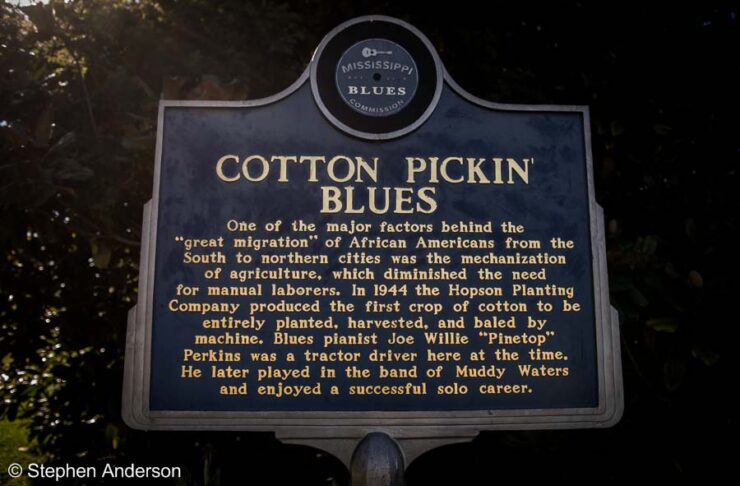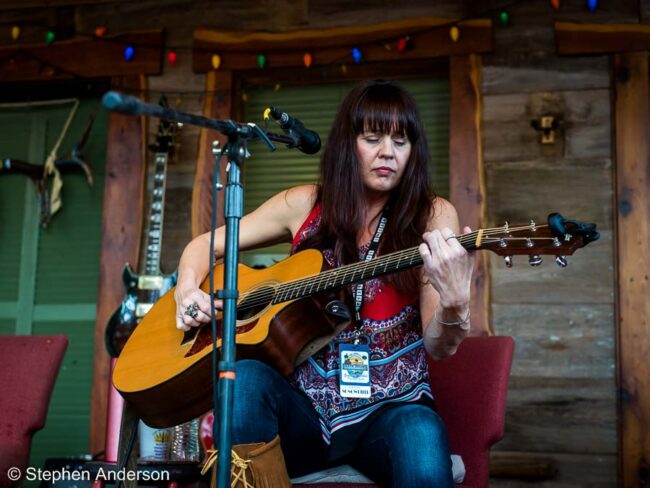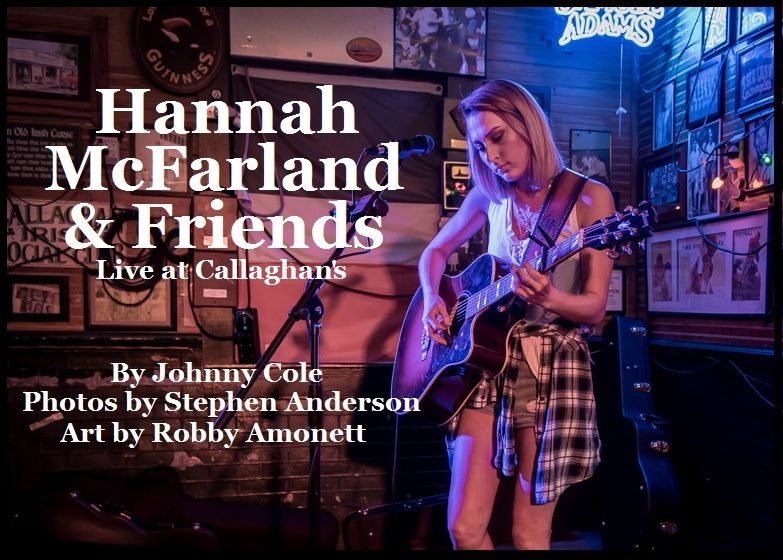Mississippi Blues Trail Series – Cotton Pickin’ Blues

An Article by Brenda Germany
Photos by Stephen Anderson
Cotton Pickin’ Blues (listed on the Mississippi Blues Trail website as Hopson Planting Co.) highlights one of the most prominent factors in the “Great Migration” of African Americans from the rural South to the North in search of employment and its effect on the evolution of blues music.
During the 1920’s to 1940’s Hopson Planting Co., originally established as Hopson Plantation in 1852, collaborated with International Harvester to develop tractor mounted cotton picking machines producing the first crop of cotton to be entirely planted, harvested, and baled by machine in 1944. Soon the technology was implemented across the South, resulting in widespread changes including the displacement of manual labor.
Joe Willie “Pinetop” Perkins’ (July 7, 1913 – March 21, 2011) was one of the many employees at Hopson Planting Co. who would be affected by the industrialization of cotton production. He spent his childhood moving around the Delta, living with his mother, relatives, and his friend, guitarist Boyd Gilmore. Although the guitar was his first musical instrument, Perkins was highly influenced by the boogie-woogie blues piano style of Clarence “Pine Top” Smith and also took up the piano in his younger years.
 Top Photo: Mississippi Blues Trail marker “Cotton Pickin’ Blues” (listed on the Mississippi Blues Trail website as Hopson Planting Co.); Above photo: Pinetop Perkins (Photo by Bill Steber taken from marker)
Top Photo: Mississippi Blues Trail marker “Cotton Pickin’ Blues” (listed on the Mississippi Blues Trail website as Hopson Planting Co.); Above photo: Pinetop Perkins (Photo by Bill Steber taken from marker)
While working at Hopson Planting Co. with other bluesmen as tractor drivers during World War II including B.B. King, Son House, and Muddy Waters, Perkins began playing juke joints, house parties and cockfights in the Clarksdale area. His first professional music job was as a guitarist with blues legend Robert Nighthawk. Although he was already becoming better known as a pianist, when Perkins’ left arm was injured in a knife fight with a chorus girl in Helena, Arkansas the injury forced him to give up the guitar. In the 1940’s Perkins played piano in radio broadcasts with Nighthawk and with Sonny Boy Williamson No. 2 (Rice Miller) on KFFA in Helena, Arkansas.
Perkins left the Delta in the late 1940s, and worked for many years in bands with Earl Hooker, Muddy Waters, and others. In the 1950s, Perkins joined Earl Hooker and began touring. He and Hooker recorded “Pinetop’s Boogie Woogie” at Sam Phillips’s Sun Studio in Memphis, Tennessee. The tune was written by Pinetop Smith and originally recorded in 1928. As Perkins recalled, “They used to call me ‘Pinetop’ because I played that song.”
Perkins then relocated to Illinois and left the music business until Earl Hooker persuaded him to record again in 1968. He also toured with the Muddy Waters band after Otis Spann left the band in 1969. After ten years with that organization, he formed the Legendary Blues Band with Willie “Big Eyes” Smith, recording from the late 1970s to the early 1990s.
He began returning to the Delta to perform after appearing at the first King Biscuit Blues Festival in Helena in 1986 and became a regular at the annual Helena festival as well as at Hopson, where an annual celebration was inaugurated in his honor in 2001. Perkins was also honored with a Mississippi Blues Trail marker in his hometown of Belzoni in 2008.
Perkins played with some of the most influential blues and rock ‘n’ roll performers of his time and received numerous honors, including a Grammy Lifetime Achievement Award and induction into the Blues Hall of Fame. Perkins influenced many blues musicians such as Ike Turner, who he taught to play piano. “Pinetop would be the birth of rock ‘n’ roll, because he taught me what I played,” Turner said.
As Clarksdale’s influence in the growth of the blues became more evident, the core of the plantation and sharecroppers houses were converted into The Shack Up Inn which includes a hotel, concert hall, and meeting venue giving Hopson Plantation a second chapter in its life. Fittingly, the former plantation now garners worldwide attention from those seeking to better understand why the link between cotton and the blues is inseparable in the history and culture of the Mississippi Delta.

Click Here for more articles in the Mississippi Blues Trail Series at The Southland Music Line.
References:
Hopson Plantation by Trevor Smith, Mississippi Gulf Coast Community College
Hopson Planting Co. – Clarksdale – content MS Blues Commission
.
Page Designed & Edited by Johnny Cole
© The Southland Music Line. 2021. All rights reserved







